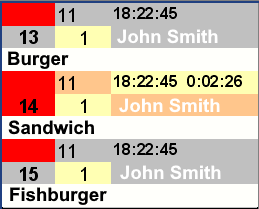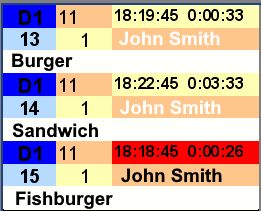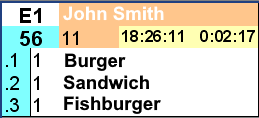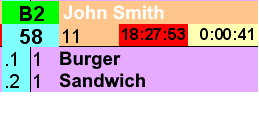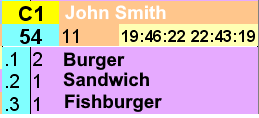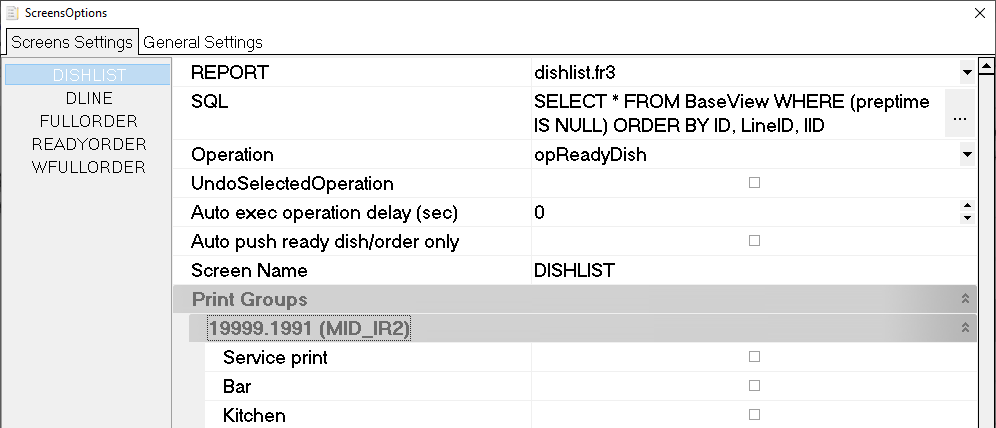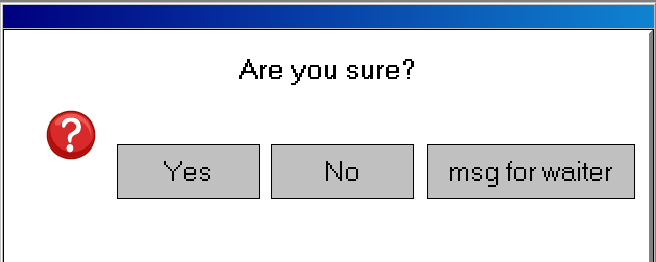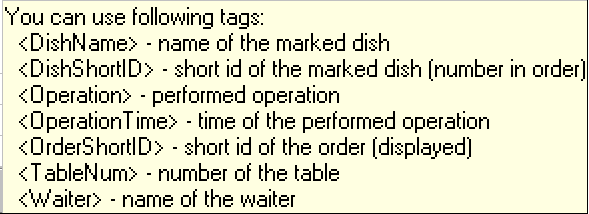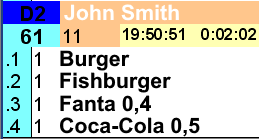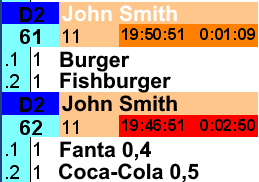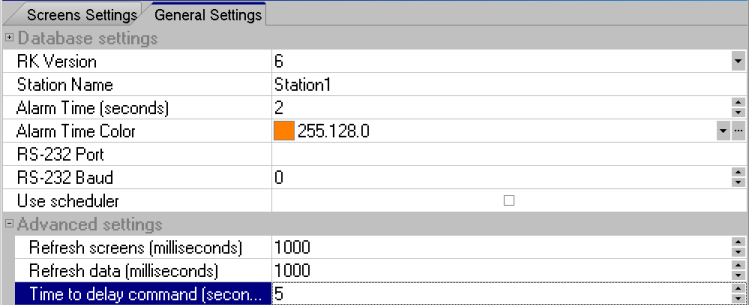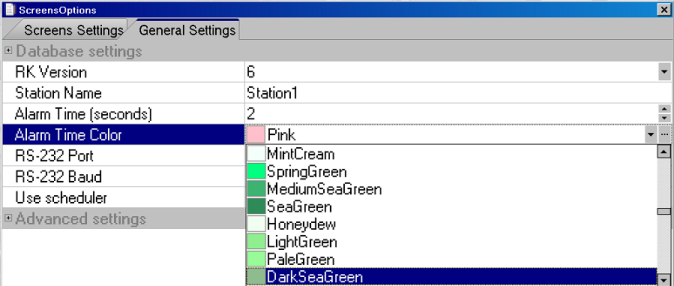...
Specify other parameters if necessary.
REPORT Field
...
| Note |
|---|
The REPORT field is used to set an active display form. You can use the |
...
default forms |
...
or create your own ones. |
Use the REPORT field to choose a form to display the dishes or the order on the KDS display:
Fig. A list of preset display forms shown.
A list of preset forms
...
The order is displayed in the form of a dynamic windows window each of which containing contains one order item (— one per dish). It supports the simultaneous delivery mode. I.e. some of the dishes in the order are displayed as inactive and show with a timer for each dish which is linked as regard to the overall preparation time.
Fig. Order displayed using the dishlist.fr3 form
- Form dishlist_by_line.fr3
The order is displayed in the form of a dynamic windows window each of which containing contains one order item (— one per dish). The simultaneous delivery mode cannot be applied in this case. I.e. the dishes from the order are displayed with a timer set for each dish individually.
Fig. Order displayed using the dishlist_by_line.fr3
- Form dline.fr3
The order is displayed in the form of lines spanning across the display with each KDS line containing one line from the order (for each individual dish and line). It supports the simultaneous delivery mode. I.e. some of the dishes in the order are displayed as inactive and show with a timer for each dish which is linked to as regard to the overall preparation time.
Fig. Order displayed using the dline.fr3 form
- Form dline_by_line.fr3
The order is displayed in the form of lines spanning across the display with each KDS line containing one line from the order (for each individual dish and line). The simultaneous delivery mode cannot be applied in this case. I.e. the dishes from the order are displayed with a timer set for each dish individually.
Fig. Order displayed using the dline_by_line.fr3 display form
- Form fullorder.fr3
The order is displayed in the form of a dynamic window which fully shows the order session (for each order) with a timer set for a dish requiring the longest preparation time.
Fig. Order displayed using the fullorder.fr3 display form
- Form NotExist.fr3
Auxiliary An auxiliary form. If the layout used in the display form gets deleted (— a file is deleted by mistake from the installation package ) — the NO EXIST message will be displayed when viewing this display form.
- Form ReadyOrder.fr3
The Take Away Waiter Mode ( waiter mode — the order is displayed in the form of a dynamic window showing the entire order session).
Fig. - Order displayed using the readyorder.fr3 display form
- Form wfullorder.fr3
- Form wfullorder.fr3
The Being Prepared waiter mode — In the Works waiter mode ( the order is displayed in the form of a dynamic window showing the entire order session).
Fig. Order displayed using the wfullorder.fr3 display form
SQL Field
...
| Note | ||
|---|---|---|
| ||
The operations algorithm of the KDS client app is set in the SQL settings field. You can choose one of the preset scripts |
...
or create |
...
your own algorithm. |
You In the SQL field, you need to choose the option for the information display rules (what we see on the KDS display) in the SQL.
- You can set the rules to display only the necessary information using the SQL request.
For instanceexample, to display only the ready dishes, dishes to be delivered, outstanding orders being prepared, etc. As the selection of a dish or an order changes their status, the KDS display will only show those meeting the request's conditions that will be highlighted in a color in accordance with corresponding to their current status. Items not meeting the request's requirements will not be displayed. For this reason at the time of , when selecting the dish or order, they will either be removed from the display, or change their highlight color.
- Several standard options are offered but the user can generate the necessary request on his/her owntheir own request.
After the dish data is transferred from the cash register station to KDS, the dish and the order get the unprocessed Unprocessed status. It is possible to change the status , i.e. assign a status, at the time of when selecting the dish or order:
| Code Block |
|---|
Status - Unprocessed ---> |
...
Status - Prepare ---> Status - Prepared |
...
Status - Prepare ---> Status - Ready |
...
Status - Deliver/Pick Up ---> Status |
...
- Taken out |
Standard Scripts Table
| Item No |
|---|
Fig. Options of ready SQL scripts set in the SQL field.
Table — Standard Scripts
| Script Name | Script | Description | |
|---|---|---|---|
1 | Not prepared | SELECT * FROM BaseView WHERE (preptime IS NULL) ORDER BY ID, LineID, IID |
|
|
|
|
|
| ||
2 | Not ready dishes | SELECT * FROM BaseView WHERE (finishcook < 0) ORDER BY ID, LineID, IID |
|
|
3 | Not ready orders | SELECT * FROM BaseView WHERE (ready < 0) ORDER BY ID, LineID, IID |
|
|
|
|
|
|
|
4 | Not |
taken out dishes | SELECT * FROM BaseView WHERE (ltakeout IS NULL) ORDER BY ID, LineID, IID |
|
|
|
|
|
5 | Not |
taked out orders | SELECT * FROM BaseView WHERE (takeout < 0) ORDER BY ID, LineID, IID |
|
|
|
|
|
|
|
|
|
|
|
|
6 | Prepared and not ready dishes | SELECT * FROM BaseView WHERE (preptime IS NOT NULL) AND (finishcook < 0) ORDER BY ID, LineID, IID |
|
7 | Prepared and not ready orders | SELECT * FROM BaseView WHERE (preptime IS NOT NULL) AND (ready < 0) ORDER BY ID, LineID, IID |
|
|
8 | Prepared and not taked out dishes | SELECT * FROM BaseView WHERE (preptime IS NOT NULL) AND (ltakeout IS NULL) ORDER BY ID, LineID, IID |
|
|
9 | Prepared and not |
taked out orders | SELECT * FROM BaseView WHERE (preptime IS NOT NULL) AND (takeout < 0) ORDER BY ID, LineID, IID |
|
|
|
10 | Ready dishes and not taked out dishes | SELECT * FROM BaseView WHERE (finishcook > 0) AND (ltakeout IS NULL) ORDER BY ID, LineID, IID |
|
|
|
|
| |
11 | Ready dishes and not |
taked out orders | SELECT * FROM BaseView WHERE (finishcook > 0) AND (takeout < 0) ORDER BY ID, LineID, IID |
|
|
|
|
12 | Ready orders and not |
taked out dishes | SELECT * FROM BaseView WHERE (ready > 0) AND (ltakeout IS NULL) ORDER BY ID, LineID, IID |
|
|
|
13 | Ready orders and not |
taked out orders | SELECT * FROM BaseView WHERE (ready > 0) AND (takeout < 0) ORDER BY ID, LineID, IID |
|
|
|
|
|
|
|
14 | Prepared dishes | SELECT * FROM BaseView WHERE (preptime IS NOT NULL) ORDER BY ID, LineID, IID |
|
15 | Ready dishes | SELECT * FROM BaseView WHERE (finishcook > 0) ORDER BY ID, LineID, IID |
|
|
|
|
16 | Ready orders | SELECT * FROM BaseView WHERE (ready > 0) ORDER BY ID, LineID, IID |
|
|
|
|
17 |
Taked out dishes | SELECT * FROM BaseView WHERE (ltakeout IS NOT NULL) ORDER BY ID, LineID, IID |
|
|
|
18 |
Taked out orders | SELECT * FROM BaseView WHERE (takeout > 0) ORDER BY ID, LineID, IID |
|
|
|
|
|
19 | All | SELECT * FROM BaseView ORDER BY ID, LineID, IID |
|
|
Operation Field
...
In the Operation field, you need to define specify the event that will take place at the time of happen when selecting the dish or the order.
- Dish and order management suggests that means changing their status will be changed during the work process.
The system uses four statuses. Once the dish is transferred from the cash register station to KDS, the dish and the order are assigned given the Not Processed status.You can make the following changes to the status of the dish and the order at the
time of selectionWhen selecting a dish, you can change the status to the following:
- Prepare
- Ready
- Deliver (TakeOut)
The status can only be changed in the following order:
Not Processed ---> Prepared ---> Ready ---> Picked Up/DeliveredTaken Out
Therefore, it is impossible, for instanceexample, to switch change the status of a dish from Not Processed to Picked Up/Delivereddirectly to Taken Out.
By default defaultm the following colors are used for highlighting each status:
- Transferred from the cash register – station — white;
- Prepared – — yellow;
- Ready – purple ;
- Delivered/Picked Up – blue .
Fig. List of available operations.
...
- — purple
- Taken Out — blue
Operations Table
Item No. | Transaction Name | Description |
0 | opNone |
|
1 | opReadyDish |
|
2 | opReadyOrder |
|
3 | opTakeOut |
|
4 | opReadyAndTakeOut |
|
5 | opTakeOutDish |
|
6 | opSendMessage |
|
7 | opReadyDishOnly |
|
8 | opPrepareDish |
|
9 | opCustom |
|
The additional fields used for the opCustom operation are shown in the figure below.Fig. Setting additional fields at the time of selecting an opCustom event.:
Screen Name
...
Field
In the Screen Name field, you should specify You should state the name of the display form to be shown on the KDS display in the Screen Name..
- The name and ordinal number of the newly created form are inserted by default.
Fig. Setting the display form name
Print Groups Field
...
In the Print Groups field, you need to select the service print groups to be shown on in this display form. Dishes from other service print groups will not be shown on in this display form.
- If none of the groups are selected, ALL groups will be shown.
Fig. Setting the visible print groups for the selected display
...
Other Settings of Screen Settings Section
View and set configure other parameters in the Screen Settings section as if required.
Table 1 — Other Screen Settings Parameters
| Item No | ||
|---|---|---|
| Parameter | Description | |
1 | Auto mark first record if record count more then one screen |
|
2 | History screen |
|
3 | Way of marking |
|
An example of how windows can be numberedwindow numbering options:
Fig. Window numbering options
- markByGenValues — by a A unique value within the display (if . If #1 is cast off reset it can be assigned to the next order)
- By RK markByOrderNumber — by an order number
- By RK7 package number
...
- from r_keeper 7
- markByPacketNumber — by a package number from r_keeper 7
| Note |
|---|
Since KDS version 1.3.0.4, a new Mark Whole Order by Order Caption Click option is available, which can only be used with the activated "Way of Marking: markByGenValues" or "MarkByOrderNumber". Allows you to perform a |
...
configured dish by dish operation for the entire order by |
...
tapping the order header |
...
Table 2 — Other Screen Settings Parameters
| Item No | ||||||||
|---|---|---|---|---|---|---|---|---|
| Parameter | Description | |||||||
4 | Barcode Scanner port |
| ||||||
5 | Barcode prefix |
| ||||||
6 | Mark first record by F1/Done |
| ||||||
7 | Confirmation on mark record |
|
A view of the The dialog box:
Fig. An additional request for confirming the action and sending the message to the waiter.
- If When using ARM, if this setting is on then when using ARM, the next setting should also be activated (— Use ARM-compatible confirmation window ).
Fig. ARM controller settings
Fig. Dialog box for confirmation
- — should also be activated
- There is a prompt note under each button for what to press on the cook's keyboard, as ARM does not support sensory input ( TS).
- Only a picture which is not a fully-fledged client is displayed.
Table 3 — Other Screen Settings Parameters
| Item No |
|---|
| Parameter | Description | |
|---|---|---|
8 | Use ARM-compatible confirmation window |
|
|
9 | Send a message to the waiter when Ready dish (RK6 only) |
|
|
| ||
10 | Move marked record to top |
|
11 | Show some last operation |
|
|
|
|
|
An example of using the Show Some Last Operation parameter:
Fig. Selecting the number of displayed last operations
Fig. Log Parameters
An example of the log parameters:
- When such settings are used, Under these settings five log lines will be displayed. The next operation will be shown as the last in the list while the first line will be deleted from the list.
Fig. A view of the set operation log on the display.
Table 4 — Other Screen Settings Parameters
| Item No | |||||||
|---|---|---|---|---|---|---|---|
| Parameter | Description | ||||||
12 | Group By: Print Group(True)/Order Number(False) |
| |||||
13 | Sound file or beep theme |
| |||||
14 | Duration of sound |
| |||||
15 | Use letter enumerateThe |
| |||||
16 | Static letter number |
| |||||
17 | Zoom |
| |||||
18 | Join By Order |
Examples of how an order is displayed using the Join By Order parameter:
| |||||
19 | Group Combo DishUsing this parameter, you can | This parameter allows to show combo dishes on the display. If the Show Combo Dish As Line parameter is enabled, the dishes will be shown as a line . If the parameter is disabled, the dishes will be shown vertically. Examples of how orders are displayed using the Show Combo Dish As Line parameter: Fig. With the Show Combo Dish As Line parameter on Fig. With the Show Combo Dish As Line parameter off Note: For the combo dishes to be displayed in the proper format you need to use the manager station directory, go to Settings ⇒ Parameters ⇒ Installation ⇒ Communication with other systems ⇒
|
Table 5 — Other Screen Settings Parameters
| Item No | |||||||||||
|---|---|---|---|---|---|---|---|---|---|---|---|
| Parameter | Description | ||||||||||
20 | Join By Order + OneKDSCheck (RK6) |
|
Example: The service print group has a minimal cipher of 1 and is called Print. The dishes within the order have service print groups with ciphers 3 (Kitchen), 8 (Bar), and 10 (Hot Kitchen). For the dishes to be shown on KDS displays it is necessary to tick all four groups.
Fig. An example of KDS server settings
- When the KDS display is set using the F2 key only the actual service print groups that use the dishes (Bar, Kitchen, Hot Kitchen) need to When configuring the KDS display in the window called by the F2 key, only the actual service print groups that use the dishes should be ticked. It is not essential obligatory to tick the Print group. You can either tick it or not. But if the Print group uses is used by the dishes for this display, you should tick it as well.
...
When using the Join By Order and OneKdsCheck=ON setting, the order on the display will be the same as entered at the cash
register (station — with the same dish sequence
) (order 1) and with— and when the OneKdsCheck=OFF
(order 2).
...
setting is used.
It is also
...
necessary to
...
make the following setting in the FSVDU.ini
...
file:
Code Block PackLines=OFFIn this case the dishes will not be packed
.
...
.
...
- When working with Ipod devices, it is necessary to set specify KDSSolid=1 in tms2.ini in section , section [TMS] (starting with — since TMS version5.39) to rule out dishes being grouped , to disable dish grouping by print service groups. This setting only operates jointly with the OneKdsCheck=ON r_keeper server keeper setting (see first order). If the setting is OneKdsCheck=OFF setting is used, the Ipod will send the orders classified by service print groups and in to different windows.
Fig. An example of an order sent from an Ipod
General Settings Section
It is necessary to specify configure the main settings in on the second tab of the General Settings tab.
Fig. The General Settings window
DataBase Settings Field
...
Fig. Connecting to the KDS database
Table 1
...
— General Settings Parameters
| Item No | ||
|---|---|---|
| Parameter | Description | |
1 | RK Version |
|
2 | Station Name |
|
3 | Alarm Time (minutes) |
|
4 | Alarm Time Color |
|
Example:
Fig. Setting the Alarm Time Color parameter
Table 2
...
— General Settings Parameters
...
| Item No | ||
|---|---|---|
| Parameter | Description | |
5 | RS-232 Port |
|
6 | RS-232 Baud |
|
7 | Use Scheduler |
|
Example:
Fig. An example of the Use Scheduler parameter setting
Table 3
...
— General Settings Parameters
...
Parameter | Description | |
8 | Refresh Screens (milliseconds) |
|
9 | Refresh data (milliseconds) |
|
10 | Time to delay command (seconds) |
|
11 | Localization |
|
Additional KDS
...
Client Settings
Changing
...
Field Colors in Display Form
Here an is an example There is a description of how to change from blue to another color in the example.
Open the display form in the report designer (by pressing the D key), find and change the following part of the set algorithm in the form code after ScreenNumberOnBeforePrint(Sender: TfrxComponent):
| Code Block |
|---|
begin |
...
if screenNumber.Color= |
...
clBlue then begin ScreenNumber.Color:=$0000DDDD; |
...
end; |
with $0000DDDD - rgb as the where $0000DDDD is for the RGB color, you can specify a color other than blue.Fig. An example of changing the field's color.
Additional KDS
...
Server Settings
- Specifying the service print groups on in the KDS server settings does not affect how they are displayed on at the KDS stations and how orders are formed on in KDS. They are required only for the process of selecting the already formed orders At KDS in KDS for the server. I.e. if some of the orders are not required at the server they can be cast off reset this way (to reduce , thus reducing the load on the server).
- If the Preparation Control function is not activated in the RK6 r_keeper 6 Editor for the service print feedflow, the service print groups will still be visible in the KDS display settings (ScreenOptions) and at the KDS server (Options), but in this case no orders will be sent to KDS from the cash register!
...
- station.
FSVDU.INI
...
Parameters
The following FSVDU.INI parameters have been added for RK7 in server settings starting from to the KDS server settings for r_keeper 7, since KDS version 1.3.1.2::
| Code Block |
|---|
UseOrderNameAsTable – It should be switched on if new persons are welcome to join a party at a table. In this case the table's full number is transmitted as OrderName |
...
AutoChangeMainWaiter – Updating the |
...
orders when changing the main waiter. |
The following FSVDU.INI parameters have been added to KDS sever settings starting since version 1.3.2:
| Code Block |
|---|
DelayTimeSec – The possibility of delaying sending a message on the readiness of a dish (in seconds) |
...
DelayedPrintGroups - Listing print groups separated by a coma, similar to the PrintGroups client settings. |
...

